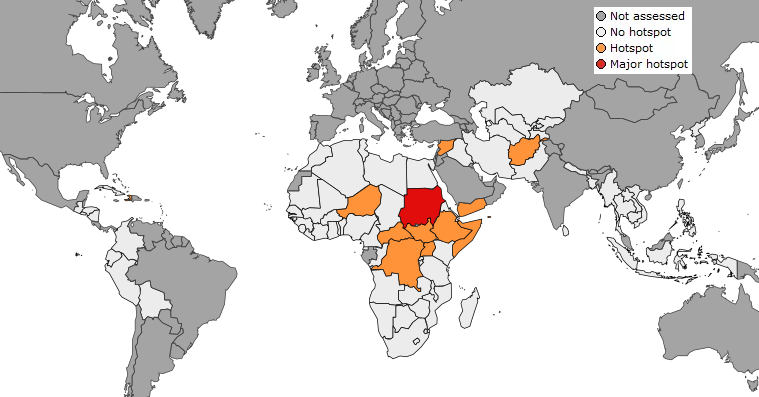
Main findings of the October global overview:
- In Southern Africa, land preparation and the planting of summer crops has started in some parts of the region. The Copernicus rainfall forecast for the November 2023-January 2024 period points to drier-than-average conditions for most of the region, except for northern Angola, northwestern Zambia and northern Mozambique where wetter-than-average conditions are forecast. The harvesting of winter wheat is nearing completion and production prospects are favourable for South Africa and Zimbabwe.
- In East Africa, production expectations for the main season in the northern part of the region are mixed due to localised drought conditions in parts of Ethiopia, Eritrea and South Sudan as well as ongoing conflicts in Sudan and in parts of Ethiopia that affected agricultural activities. The main season crop production in Kenya’s unimodal areas is expected to be close to average, but poor vegetation conditions for second season crop are observed in Uganda. The seasonal rainfall forecasts by ICPAC and Copernicus C3S Multimodel for the remainder of the short rains season point to above-average rains that can benefit crop and rangeland conditions, but also pose a risk of flooding.
- In West and Central Africa, the main season is coming to an end and the preliminary forecast for cereal production is around 77.8 million tonnes, similar to the level of the previous year and 6% above the 5-year average (FAO). Pastoral conditions are generally good across the region and positive livestock production is expected; however, pasture development is below average in parts of Niger (Dosso, Diffa) and Chad (Kanem, Lac, Batha).
- In the Middle East, the harvest of irrigated summer crops ended with mixed prospects: favourable in northern Syria, poor in Iraq and mixed for rice in Iran. The sowing of winter cereals has started under average conditions. In Yemen, where the wheat has been harvested and the harvest of sorghum will be completed in November, prospects are close to average according to crop biomass. Food insecurity in the country continues to affect almost half of the population.
- In Central Asia, the sowing of winter wheat is underway under near-average conditions, while rainfall is forecast to be above average for the whole region in the next three months. In Afghanistan, the sowing of winter wheat is underway under near-average conditions. In South Asia, the harvest of summer (Kharif) crops is underway in Pakistan with average prospects, while the production of wet season (aman) rice in Bangladesh is expected to be above average. In Sri Lanka, the planting of main season rice and maize is underway under favourable conditions.
- In continental south-east Asia, the harvest of main season rice is underway with average to above-average prospects in the whole region. In Indonesia, the harvest of dry season rice is underway with near-average prospects, while the planting of main season rice and maize is delayed as a result of the dry conditions caused by a strong El Niño. In North Korea, the harvest of rice and maize ended with above-average expectations.
- In Latin America and the Caribbean islands, ongoing harvests of maize and rice point to good prospects in most cropping areas. The Postrera cycles and maize and rice cycles are establishing under average conditions, although poor vegetation conditions are observed in the key producing department of Petén (Guatemala). The sowing of rice in Bolivia is likely facing difficulties due to the poor rainfall conditions affecting key grain-producing departments, including Santa Cruz. The sowing of maize and rice is affected in the San Martin department of Peru due to a lack of rainfall in the past three months.
The next assessment is scheduled for the end of November 2023.
Details
- Publication date
- 13 November 2023
- Author
- Joint Research Centre
- JRC portfolios




